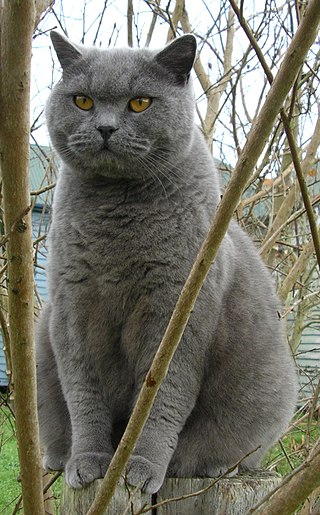
The British Shorthair is the pedigreed version of the traditional British domestic cat, with a distinctively stocky body, thick coat, and broad face. The most familiar colour variant is the "British Blue", with a solid grey-blue coat, pineapple eyes, and a medium-sized tail. The breed has also been developed in a wide range of other colours and patterns, including tabby and colourpoint.
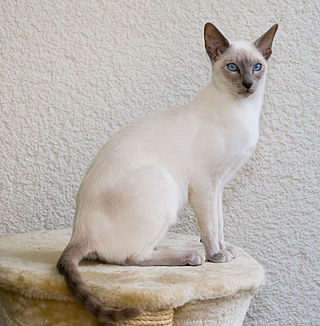
The Siamese cat is one of the first distinctly recognised breeds of Asian cat. Derived from the Wichianmat landrace, one of several varieties of cats native to Thailand, the original Siamese became one of the most popular breeds in Europe and North America in the 19th century. Siamese cats have a distinctive colourpoint coat, resulting from a temperature-sensitive type of albinism.

A bicolor cat is a cat with white fur combined with fur of some other color, for example solid black, tabby, or colorpointed. There are various patterns of bicolor cat. These range from the Van-patterned through to solid color with a throat locket or medallion. Bicolor coats are found in many cat breeds, as well as being common in domestic longhair and domestic shorthair cats.
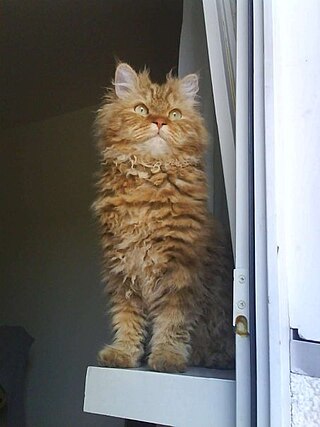
The Selkirk Rex is a breed of cat with highly curled hair.

The Russian Blue cat, commonly referred to as just Russian Blue, is a cat breed with colors that vary from a light shimmering silver to a darker, slate grey. The short, dense coat, which stands out from the body, has been the breed's hallmark for more than a century.

The Cymric is a Canadian cat breed. Some cat registries consider the Cymric a semi-long-haired variety of the Manx breed, rather than a separate breed. Except for the length of fur, in all other respects, the two varieties are the same, and kittens of either sort may appear in the same litter. The name comes from Cymru, the indigenous Welsh name of Wales, even though the breed is not associated with Wales. The name may have been chosen to provide a "Celtic" sounding moniker for the breed. While the breed's Manx bloodline originated from the Isle of Man, the long-haired variant is claimed to have been developed by Canada. The breed is called the Longhair Manx or a similar name by some registries.

The American Bobtail is an uncommon breed of domestic cat which was developed in the late 1960s. It is most notable for its stubby "bobbed" tail about one-third to one-half the length of a normal cat's tail. This is the result of a cat body type genetic mutation affecting the tail development, similar to that of a Manx cat. The breed is not related to other short-tailed breeds, such as the Cymric cat, or the Japanese Bobtail or Kurilian Bobtail, despite the similar name and physical type—the breeding programs are entirely unrelated, and the genetic mutation causing the bobbed tail are known to be different, as the mutation causing the American Bobtail's short tail is dominant; comparatively, the Japanese Bobtail, for example, has a tail mutation that is recessive.

The Havana Brown was the result of a planned breeding between Siamese and domestic black cats, by a group of cat fanciers in England, in the 1950s. Early breeders introduced a Siamese type Russian Blue into their breeding. However, using current genetic testing, it is believed that almost none remain in the gene pool.
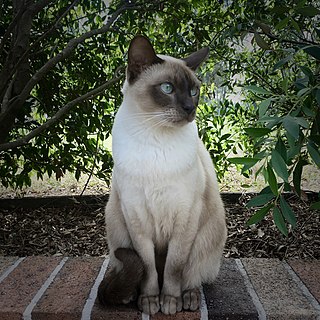
Tonkinese is a domestic cat breed produced by crossbreeding between the Siamese and Burmese. Members of the breed are distinguished by a pointed coat pattern in a variety of colors. In addition to the modified coat colors of the "mink" pattern, which is a dilution of the point color, the breed is now being shown in the foundation-like Siamese and Burmese colors: pointed with white and solid overall (sepia).

Cat coat genetics determine the coloration, pattern, length, and texture of feline fur. The variations among cat coats are physical properties and should not be confused with cat breeds. A cat may display the coat of a certain breed without actually being that breed. For example, a Neva Masquerade could wear point coloration, the stereotypical coat of a Siamese.

The Javanese, also known as the ColorpointLonghair in some registries, is a variety of purebred domestic cat.
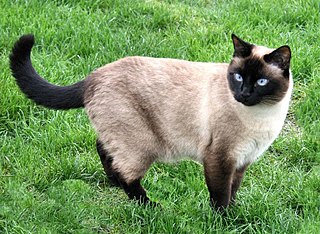
Point coloration is animal coat coloration with a pale body and relatively darker extremities, i.e. the face, ears, feet, tail, and scrotum. It is most recognized as the coloration of Siamese and related breeds of cat, but can be found in dogs, rabbits, rats, sheep, guinea pigs and horses as well.
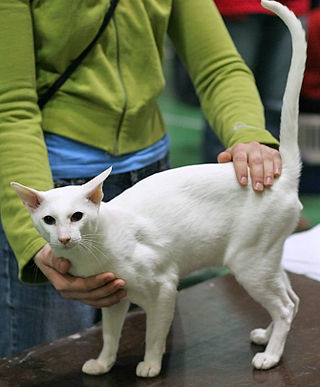
The Foreign White is cat breed recognised by the Governing Council of the Cat Fancy (GCCF) and the Australian Cat Federation (ACF); in some other registries it is considered simply a color variety of the Siamese or Oriental Shorthair breeds, and not a breed unto itself. The Foreign White is characterized by its long body, triangle-shaped face, uniformly white coat, and deep blue eyes.

The Oriental Longhair is a variety of domestic cat. It is closely related to the Oriental Shorthair. The Oriental Longhair in some registries, such as The International Cat Association (TICA), is a separate breed. In others, such as the Cat Fanciers' Association (CFA), it is a division, along with the short-haired variety, of a merged breed, the Oriental. With no globally recognised naming convention, other cat fanciers may refer to this type as Foreign Longhair, Javanese or Mandarin. It was formerly known as the British Angora before being renamed in 2002 by British cat fanciers in order to avoid confusion with the Turkish Angora.

The Colorpoint Shorthair is a variety of Siamese cat. The only major registries to recognise them are the Cat Fanciers' Association (CFA) and the World Cat Federation (WCF). This breed was established from breeding American Shorthairs with the Siamese to produce different point colors, beyond the four standard Siamese colors.
A cat registry or cat breed registry, also known as a cat fancier organization, cattery federation, or cat breeders' association, is an organization that registers domestic cats of many breeds, for exhibition and for breeding lineage tracking purposes. A cat registry stores the pedigrees (genealogies) of cats, cattery names, and other details of cats; studbooks, breed descriptions, and the formal breed standards ; lists of judges qualified to judge at shows run by or affiliated with that registry, and sometimes other information. A cat registry is not the same as a breed club or breed society. Cat registries each have their own rules and usually also organize or license (sanction) cat shows. The show procedures vary widely, and awards won in one registry are not normally recognized by another. Some registries only serve breeders, while others are oriented toward pet owners and provide individual as well as cattery memberships, while yet others are federations only deal with breed clubs or even other registries as intermediaries between the organization and breeders.

An Oriental bicolour is any cat of Oriental type, either long-haired or short-haired and in any pattern including colourpoint, which has white areas on its coat caused by the white spotting gene. In most cat fancier and breeder organisations, Oriental bicolours do not constitute a standardised breed, but a coat pattern variant of the breed of their foundation stock. One breed registry is an exception, the UK-based Governing Council of the Cat Fancy (GCCF), which has defined them as a separate breed named Oriental Bicolour (capitalised).
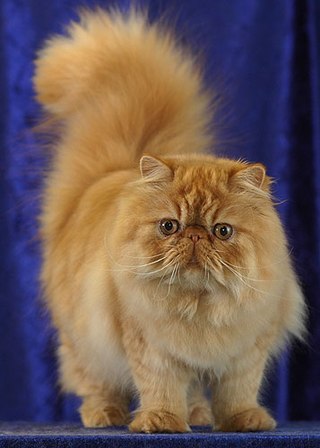
The Persian cat, also known as the Persian Longhair, is a long-haired breed of cat characterised by a round face and short muzzle. The first documented ancestors of Persian cats might have been imported into Italy from Khorasan as early as around 1620, however, this has not been proven. Instead, there is stronger evidence for a longhaired cat breed being exported from Afghanistan and Iran from the 19th century onwards. Widely recognised by the North-West European cat fancy since the 19th century, and after World War II by breeders from North America, Australia and New Zealand. Some cat fancier organisations' breed standards subsume the Himalayan and Exotic Shorthair as variants of this breed, while others generally treat them as separate breeds.

The Balinese is a long-haired breed of domestic cat with Siamese-style point coloration and sapphire-blue eyes. The Balinese is also known as the purebred long-haired Siamese since it originated as a natural mutation of that breed and hence is essentially the same cat but with a medium-length silky coat and a distinctively plumed tail.



























